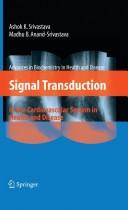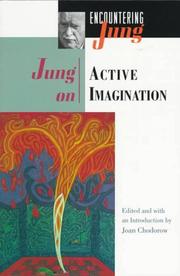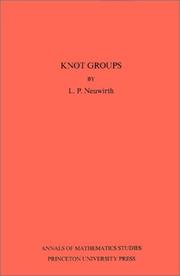| Listing 1 - 5 of 5 |
Sort by
|

ISBN: 3540095519 0387095519 148999856X 0387095527 3540348603 9783540095514 9780387095516 Year: 1979 Volume: 171 Publisher: Berlin: Springer,
Abstract | Keywords | Export | Availability | Bookmark
 Loading...
Loading...Choose an application
- Reference Manager
- EndNote
- RefWorks (Direct export to RefWorks)
Signal Transduction in Cardiovascular System in Health and Disease Madhu B. Anand- Srivastava and Ashok K. Srivastava This book has addressed the contributions of several key signal transduction pathways which are central to our understanding of cardiovascular physiology and pathophysiology. Aberrations in these signaling events have been suggested to be involved in a host of cardiovascular pathologies, such as cardiac arrhythmias, congenital heart failure and hypertension. All the chapters have been written by well known leaders in the fields, which cover a wide range of intracellular events that regulate various aspects of cardiovascular functions. This book will be of interest to both basic as well as clinical scientists seeking to understand the molecular basis of cardiovascular diseases, and also to those interested in defining targets for cardiovascular pharmacotherapy. About the Authors Dr. Madhu B. Anand-Srivastava is a Professor, Department of Physiology, and a member of the Group de recherche sur le système nerveux autonome, University of Montréal. In 1990, she received a prestigious Scientist Award from Medical Research Council of Canada and in 2004, she was bestowed with the Vincenzo Panagia Distinguished Lecturer award from the Institute of Cardiovascular Sciences of the University of Manitoba, Winnipeg. She is an internationally recognized expert in the area of G-protein and natriuretic peptide receptor-C signaling, and has made significant contributions in defining the role of Gia proteins in the pathogenesis of hypertension. She has published more than 125 papers in refereed journals and edited 3 books in the area of G-proteins, hypertension and NPR-C receptor and cell signaling, and has been invited to several National and International conferences and academic institutions to present her work. Dr. Anand-Srivastava has served or is currently on different committees of the Canadian Institutes of Health Research and Heart and Stroke Foundation of Canada, and is also on the editorial boards of several scientific publications, including the Journal of Molecular and Cellular Cardiology and Molecular and Cellular Biochemistry. She has also organized several National and International conferences on cell signaling in cardiovascular system. Dr. Ashok K. Srivastava is a Professor at the Department of Medicine, Université de Montréal, and Head of the Laboratory of Cell Signaling at the Research Center of the Centre hospitalier de l’Université de Montréal (CHUM). He has over 100 publications in fields of insulin, vasoactive peptide and redox signaling, and cardiovascular complications. He has served or is serving as a guest editor of many journals such as Antioxidant and Redox Signaling, Canadian Journal of Physiology and Pharmacology, Cell Biochemistry and Biophysics and Molecular and Cellular Biochemistry, and is currently a member of the editorial boards of Advances in Biochemistry in Health and Disease and Recent Patents on Endocrine, Metabolic and Immune Drug Discovery. Dr. Srivastava is also on the grant review panels of the Canadian Institutes of Health Research, the Heart and Stroke Foundation of Canada and the National Institutes of Health. He has also organized several International symposia and workshops on Second Messengers and cell signaling.
Ordered algebraic structures --- Commutative rings. --- Representations of groups. --- Symmetry groups. --- Wreath products (Group theory). --- Cardiovascular system --- Cellular signal transduction. --- Diseases --- Molecular aspects. --- Commutative rings --- Representations of groups --- Symmetry groups --- Wreath products (Group theory) --- Products, Wreath (Group theory) --- Group theory --- Groups, Symmetry --- Symmetric groups --- Crystallography, Mathematical --- Quantum theory --- Group representation (Mathematics) --- Groups, Representation theory of --- Rings (Algebra) --- Queuing theory --- Files d'attente, Théorie des --- Cardiology. --- Human physiology. --- Biochemistry. --- Human Physiology. --- Medical Biochemistry. --- Biochemistry, general. --- Biological chemistry --- Chemical composition of organisms --- Organisms --- Physiological chemistry --- Biology --- Chemistry --- Medical sciences --- Human biology --- Physiology --- Human body --- Heart --- Internal medicine --- Composition --- Medical biochemistry. --- Medical biochemistry --- Pathobiochemistry --- Pathological biochemistry --- Biochemistry --- Pathology --- Groupes, Théorie des --- Groupes, Théorie des --- Représentations de groupes
Book
Year: 2020 Publisher: Basel, Switzerland MDPI - Multidisciplinary Digital Publishing Institute
Abstract | Keywords | Export | Availability | Bookmark
 Loading...
Loading...Choose an application
- Reference Manager
- EndNote
- RefWorks (Direct export to RefWorks)
Leonhard Euler (1707–1783) was born in Basel, Switzerland. Euler's formula is a mathematical formula in complex analysis that establishes the fundamental relationship between the trigonometric functions and the complex exponential function. When its variable is the number pi, Euler's formula evaluates to Euler's identity. On the other hand, the Yang–Baxter equation is considered the most beautiful equation by many scholars. In this book, we study connections between Euler’s formulas and the Yang–Baxter equation. Other interesting sections include: non-associative algebras with metagroup relations; branching functions for admissible representations of affine Lie Algebras; super-Virasoro algebras; dual numbers; UJLA structures; etc.
transcendental numbers --- Euler formula --- Yang–Baxter equation --- Jordan algebras --- Lie algebras --- associative algebras --- coalgebras --- Euler’s formula --- hyperbolic functions --- UJLA structures --- (co)derivation --- dual numbers --- operational methods --- umbral image techniques --- nonassociative algebra --- cohomology --- extension --- metagroup --- branching functions --- admissible representations --- characters --- affine Lie algebras --- super-Virasoro algebras --- nonassociative --- product --- smashed --- twisted wreath --- algebra --- separable --- ideal --- n/a --- Yang-Baxter equation --- Euler's formula
Book
Year: 2020 Publisher: Basel, Switzerland MDPI - Multidisciplinary Digital Publishing Institute
Abstract | Keywords | Export | Availability | Bookmark
 Loading...
Loading...Choose an application
- Reference Manager
- EndNote
- RefWorks (Direct export to RefWorks)
Leonhard Euler (1707–1783) was born in Basel, Switzerland. Euler's formula is a mathematical formula in complex analysis that establishes the fundamental relationship between the trigonometric functions and the complex exponential function. When its variable is the number pi, Euler's formula evaluates to Euler's identity. On the other hand, the Yang–Baxter equation is considered the most beautiful equation by many scholars. In this book, we study connections between Euler’s formulas and the Yang–Baxter equation. Other interesting sections include: non-associative algebras with metagroup relations; branching functions for admissible representations of affine Lie Algebras; super-Virasoro algebras; dual numbers; UJLA structures; etc.
Research & information: general --- Mathematics & science --- transcendental numbers --- Euler formula --- Yang-Baxter equation --- Jordan algebras --- Lie algebras --- associative algebras --- coalgebras --- Euler's formula --- hyperbolic functions --- UJLA structures --- (co)derivation --- dual numbers --- operational methods --- umbral image techniques --- nonassociative algebra --- cohomology --- extension --- metagroup --- branching functions --- admissible representations --- characters --- affine Lie algebras --- super-Virasoro algebras --- nonassociative --- product --- smashed --- twisted wreath --- algebra --- separable --- ideal

ISBN: 0691015767 1322882010 1400866855 Year: 2015 Publisher: Princeton, NJ : Princeton University Press,
Abstract | Keywords | Export | Availability | Bookmark
 Loading...
Loading...Choose an application
- Reference Manager
- EndNote
- RefWorks (Direct export to RefWorks)
All the creative art psychotherapies (art, dance, music, drama, poetry) can trace their roots to C. G. Jung's early work on active imagination. Joan Chodorow here offers a collection of Jung's writings on active imagination, gathered together for the first time. Jung developed this concept between the years 1913 and 1916, following his break with Freud. During this time, he was disoriented and experienced intense inner turmoil --he suffered from lethargy and fears, and his moods threatened to overwhelm him. Jung searched for a method to heal himself from within, and finally decided to engage with the impulses and images of his unconscious. It was through the rediscovery of the symbolic play of his childhood that Jung was able to reconnect with his creative spirit. In a 1925 seminar and again in his memoirs, he tells the remarkable story of his experiments during this time that led to his self-healing. Jung learned to develop an ongoing relationship with his lively creative spirit through the power of imagination and fantasies. He termed this therapeutic method "active imagination." This method is based on the natural healing function of the imagination, and its many expressions. Chodorow clearly presents the texts, and sets them in the proper context. She also interweaves her discussion of Jung's writings and ideas with contributions from Jungian authors and artists.
Jungian psychology. --- Psychoanalysis. --- Subconsciousness. --- Active imagination. --- Jung, C. G. --- Active imagination. --- Adlerian. --- Allusion. --- Analogy. --- Analytical psychology. --- Anima and animus. --- Anthropomorphism. --- Antithesis. --- Apotropaic magic. --- Archetype. --- Art therapy. --- Astrology. --- Author. --- Career. --- Carl Jung. --- Causality. --- Certainty. --- Cherry picking. --- Circumference. --- Clockwise. --- Cloister. --- Co-operation (evolution). --- Consciousness. --- Critical period. --- Criticism. --- Dialectic. --- Direct experience. --- Disgust. --- Dissociation (psychology). --- Dream interpretation. --- Explanation. --- Extraversion and introversion. --- Feeling. --- Free association (psychology). --- Hallucination. --- Humility. --- Ibid. --- Imagination. --- Indication (medicine). --- Individuation. --- Inner Experience. --- Inner critic. --- Introspection. --- Invention. --- Lao-Tzu. --- Lecture. --- Libido. --- Literature. --- Loneliness. --- Mental image. --- Mood (psychology). --- Multitude. --- Mysterium Coniunctionis. --- Neglect. --- Neurosis. --- Nihilism. --- Oppression. --- Parapsychology. --- Personality. --- Phenomenon. --- Philosophy. --- Potentiality and actuality. --- Prejudice. --- Prima materia. --- Principle. --- Probability. --- Psyche (psychology). --- Psychoanalysis. --- Psychologist. --- Psychology and Alchemy. --- Psychology. --- Psychotherapy. --- Puberty. --- Rapprochement. --- Rationality. --- Reality. --- Reincarnation. --- Result. --- Sanskrit. --- Self-confidence. --- Self-deception. --- Self-knowledge (psychology). --- Sigmund Freud. --- Singing. --- Suffering. --- Suggestion. --- Suicide. --- Symptom. --- Temperament. --- The Erotic. --- The Interpretation of Dreams. --- The Secret of the Golden Flower. --- Therapeutic effect. --- Thought. --- Toni Wolff. --- Transference. --- Two Essays on Analytical Psychology. --- Uncertainty. --- Wreath. --- Writing.

ISBN: 0691079919 1400882036 9780691079912 Year: 1965 Volume: 56 Publisher: Princeton (N.J.): Princeton university press,
Abstract | Keywords | Export | Availability | Bookmark
 Loading...
Loading...Choose an application
- Reference Manager
- EndNote
- RefWorks (Direct export to RefWorks)
The description for this book, Knot Groups. Annals of Mathematics Studies. (AM-56), Volume 56, will be forthcoming.
Topology --- 512 --- Algebra --- 512 Algebra --- Knot theory. --- Knots (Topology) --- Low-dimensional topology --- Abelian group. --- Alexander duality. --- Alexander polynomial. --- Algebraic theory. --- Algorithm. --- Analytic continuation. --- Associative property. --- Automorphism. --- Axiom. --- Bijection. --- Binary relation. --- Calculation. --- Central series. --- Characterization (mathematics). --- Cobordism. --- Coefficient. --- Cohomology. --- Combinatorics. --- Commutator subgroup. --- Complete theory. --- Computation. --- Conjugacy class. --- Conjugate element (field theory). --- Connected space. --- Connectedness. --- Coprime integers. --- Coset. --- Covering space. --- Curve. --- Cyclic group. --- Dehn's lemma. --- Determinant. --- Diagonalization. --- Diagram (category theory). --- Dimension. --- Direct product. --- Equivalence class. --- Equivalence relation. --- Euclidean space. --- Euler characteristic. --- Existential quantification. --- Fiber bundle. --- Finite group. --- Finitely generated module. --- Frattini subgroup. --- Free abelian group. --- Fundamental group. --- Geometry. --- Group ring. --- Group theory. --- Group with operators. --- Hausdorff space. --- Homeomorphism. --- Homology (mathematics). --- Homomorphism. --- Homotopy group. --- Homotopy. --- Identity matrix. --- Inner automorphism. --- Interior (topology). --- Intersection number (graph theory). --- Knot group. --- Linear combination. --- Manifold. --- Mathematical induction. --- Monomorphism. --- Morphism. --- Morse theory. --- Natural transformation. --- Non-abelian group. --- Normal subgroup. --- Orientability. --- Permutation. --- Polynomial. --- Presentation of a group. --- Principal ideal domain. --- Principal ideal. --- Root of unity. --- Semigroup. --- Simplicial complex. --- Simply connected space. --- Special case. --- Square matrix. --- Subgroup. --- Subset. --- Summation. --- Theorem. --- Three-dimensional space (mathematics). --- Topological space. --- Topology. --- Torus knot. --- Transfinite number. --- Trefoil knot. --- Trichotomy (mathematics). --- Trivial group. --- Triviality (mathematics). --- Two-dimensional space. --- Unit vector. --- Wreath product.
| Listing 1 - 5 of 5 |
Sort by
|

 Search
Search Feedback
Feedback About UniCat
About UniCat  Help
Help News
News